
Jan Romuald Byzewski, better known in America as Father Romuald Byzewski, was born in the Kaszubian village of Karwia, [1] in the Prussian jurisdiction of Danzig (Gdansk), on October 10, 1842.

Jan Romuald Byzewski, better known in America as Father Romuald Byzewski, was born in the Kaszubian village of Karwia, [1] in the Prussian jurisdiction of Danzig (Gdansk), on October 10, 1842.
After graduating from secondary school in Wejherowo he entered the Franciscan Recollect Province as a novice on February 7, 1861. Since this was the feast of Saint Romuald. he added the name Romuald to his own. He was ordained to the Roman Catholic priesthood at Liège, Belgium, on August 5, 1866. After his ordination, Reverend Byzewski became professor of philosophy and theology at the Franciscan seminary in Łąki Bratiańskie, Poland. [2] In 1875, at the height of the Kulturkampf, the Congregations Law was enacted, effectively forbidding Roman Catholic religious orders to operate within the Prussian Empire. Reverend Byzewski was consequently permitted to leave the Franciscans and emigrate to the United States, thereby becoming part of the Kaszubian diaspora.
Reverend Byzewski arrived in New York on August 13, 1875, aboard the SS Mosel. [3] His first service in America was as pastor of Saint Stanislaus Kostka Parish in Winona, Minnesota. He served in this role until 1890, helped no doubt by his Kashubian heritage in a city which came to be known as the "Kashubian Capital of America." [4] He established a school for the parish, brought in the School Sisters of Notre Dame to teach there, and served as a capable intermediary between the English-speaking majority and the bumptious Kaszubian Poles. As a stalwart supporter of the Polish Roman Catholic Union of America he also established the newspaper Wiarus, which quickly became the United States's leading Polish-language periodical, under the editorship of the mercurial Kaszubian poet Hieronim Derdowski. According to the historian-priest Reverend Waclaw Kruszka, unexplained “disagreements and difficulties” may have sped Father Byzewski's departure from Winona. [5]
An 1890 city directory for Milwaukee, Wisconsin lists Reverend Byzewski as an assistant pastor at Saint Stanislaus Church at 404 Mitchell Street. Yet by June 1890, he was in Detroit, Michigan directing the foundation of that city's fifth Polish parish, Saint Francis of Assisi. In 1898 he was transferred to Sweetest Heart of Mary Roman Catholic Church, also in Detroit. In 1899, Reverend Byzewski was granted readmission to the Franciscan Order, and relocated to Pulaski, Wisconsin. There he was a pastor for parishes and served as the first rector of Saint Bonaventure College.
Reverend Jan Romuald Byzewski died in Green Bay, Wisconsin, on October 30, 1905. His grave is at Franciscan Fathers Cemetery in Pittsville, Wisconsin.
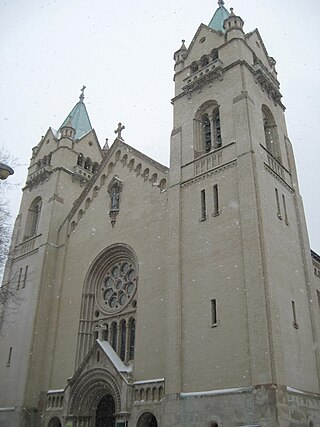
St. Josaphat is a historic church of the Roman Catholic Archdiocese of Chicago located at 2311 North Southport Avenue in Chicago, Illinois.
Michał Kruszka or Michael Kruszka was a Polish American immigrant, politician, and journalist. He served four years in the Wisconsin State Senate and two years in the State Assembly, representing Milwaukee's south side and southern Milwaukee County. He was the first Polish American member of the Wisconsin Legislature.
Edward Kozlowski was a Polish-American prelate of the Roman Catholic Church who served as an auxiliary bishop for the Archdiocese of Milwaukee, in Milwaukee, Wisconsin. He was the first Polish bishop for Milwaukee.
Wacław Kruszka was a Polish-American priest, journalist, social activist, and author.
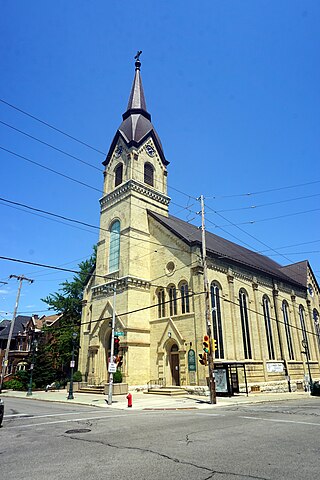
St. Hedwig's Roman Catholic Church, is a church and former parish of the Roman Catholic located at 1702 N. Humboldt Ave. on Milwaukee, Wisconsin's East Side at the center of the East Brady Street Historic District, in the Roman Catholic Archdiocese of Milwaukee.
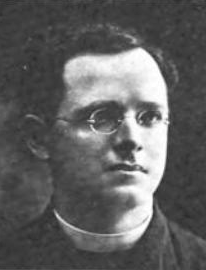
Boleslaus Edward Goral or Góral was a Polish-American priest, professor, and newspaper editor.
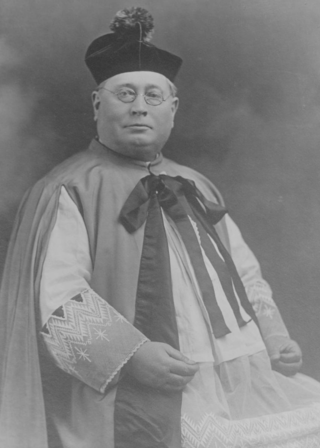
Hyacinth Gulski was a pioneer Polish-American Roman Catholic priest. He served as Archdiocesan Consultor to the Roman Catholic Archdiocese of Milwaukee.
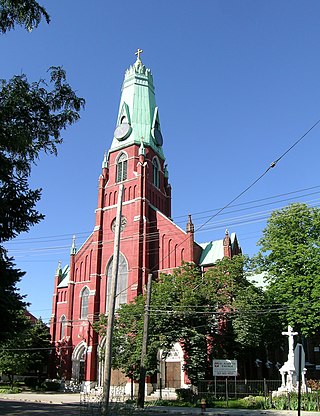
St. Albertus Roman Catholic Church is in the Forest Park neighborhood of Detroit, Michigan. It was designated a Michigan State Historic Site in 1974 and listed on the National Register of Historic Places in 1978.
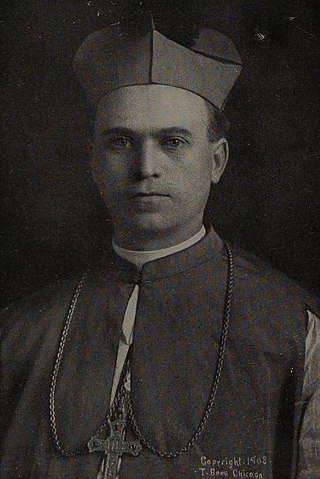
Paul Peter Rhode was a German-born prelate of the Roman Catholic Church. He served as bishop of the Diocese of Green Bay in Wisconsin from 1915 until his death in 1945.
Pine Creek is an unincorporated community located in the town of Dodge, Trempealeau County, Wisconsin, United States. Pine Creek is located on Pine Creek and County Highway G 9.6 miles (15.4 km) west-northwest of Galesville.

The Basilica of Saint Stanislaus Kostka is a historic church of the Roman Catholic Diocese of Winona in Winona, Minnesota, United States, and a prominent fixture on the city's skyline. Within the diocese it is better known as Saint Stan's. It was listed on the National Register of Historic Places in 1984 as Church of St. Stanislaus–Catholic and was designated as a Minor Basilica of the Roman Catholic Church on November 10, 2011 by Pope Benedict XVI.
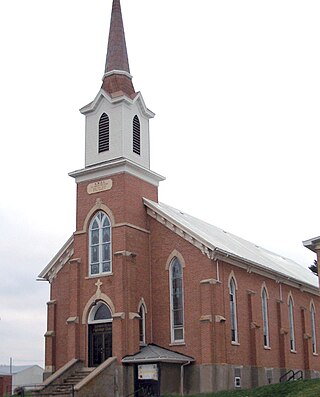
Sacred Heart-Saint Wenceslaus Church in Pine Creek, Wisconsin, referred to in Polish as Kościół Najświętszego Serca Pana Jezusa i Świętego Wacława, is a historic church of the Roman Catholic Diocese of La Crosse. It is known simply as Sacred Heart.
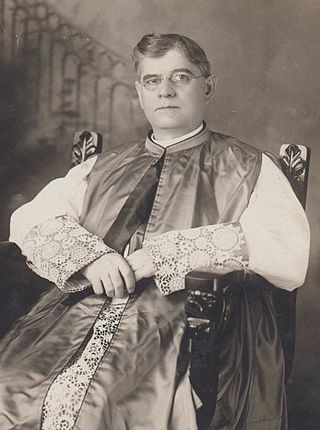
Jakub Wałenty Jan Pacholski, better known in America as Monsignor James W.J. Pacholski, was born on May 24, 1862, in the village of Pączewo, located in the Polish region of Kociewie.
Józef Franciszek Darzyn Ciemiński was a Polish-born Roman Catholic priest. He emigrated with his parents to the United States in 1881 and was ordained as a Priest in Saint Paul, Minnesota in 1895. He was involved with numerous Polish Catholic parishes during his lifetime including the now closed troubled Parish of Saints Peter and Paul in Duluth, Minnesota, and the parish of Holy Cross in Minneapolis.
The Kashubian diaspora resulted from the emigration of Kashubians mainly in two waves occurring in the second half of the 19th century. The majority of Kashubian emigrants settled in the United States; others emigrated to Canada and Brazil. An online genealogical project, "The Great Kashubian Migration," is devoted to tracking their settlement patterns. Their reasons for emigration varied. Until the Franco-Prussian War, Kashubians emigrated primarily for economic reasons. After the Franco-Prussian War and especially due to the Kulturkampf, Kashubian emigration accelerated as socio-political factors came into play. In his 1899 book, Statystyka ludnosci kaszubskiej, the Kashubophile linguist and sociologist Stefan Ramult estimated that 130,700 Kashubians were living in the Americas.
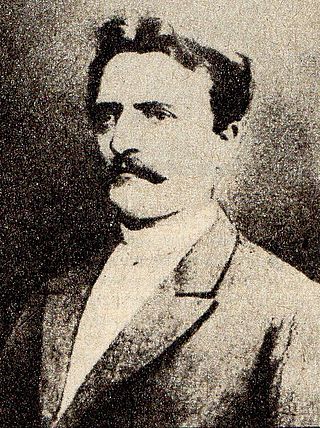
Hieronim Derdowski, Kashubian-Polish intellectual and activist, was born to Kashubian parents in the Pomeranian village of Wiele. By the time Derdowski emigrated to the United States in 1885, he had already studied for the Roman Catholic priesthood, been repeatedly incarcerated by the German authorities, and edited a newspaper in the city of Torun. At the time, however, Derdowski was better known as a poet. Within two years of reaching the United States he became editor of the Winona, Minnesota Polish-language newspaper Wiarus. In this role he gained a reputation as a strong voice for the Polish-American community, also known as Polonia.
Wiarus was the name of a Polish-language newspaper published in Winona, Minnesota from 1886 to 1893 and 1895 to 1919; in 1893 it was renamed Katolik, but reverted to its original name in 1895. Although Winona's Polish community was known at the time as the "Kashubian Capital of America," Wiarus was published in the "good" Polish spoken in Warsaw and Krakow. Wiarus also provided printing services for Winona's Kashubian Polish community. From 1886 to 1902, Wiarus was edited by the famed Kashubian-born poet and journalist Hieronim Derdowski. In its heyday, Wiarus was said to be the most widely circulated Polish-language newspaper in the United States.
Paul Joseph Breza, Roman Catholic priest and Kashubian American activist, was born in Winona, Minnesota on June 23, 1937, the son of Joseph Peter and Alice Seraphine (Pehler) Breza, both of whom were descendants of Kashubian immigrants from Bytów, Poland. He was educated at Saint Stanislaus Kostka School, Cotter High School and Saint Mary's University of Minnesota.
Antoni Klawiter, the Roman Catholic and, afterward, independent Polish Catholic priest, was born in Chojnice, in modern Poland, on November 12, 1836. The scholarly consensus is that he was the son of Polonized Germans; by virtue of his Kashubian birthplace and his later experience pastoring Kashubians in Winona, Minnesota, he will not have been unfamiliar with the Kashubian culture. In 1859, he was ordained a Roman Catholic priest in Włocławek, and became four years afterward one of many Polish priests who were involved with the Polish Insurrection of 1863. In late 1873 or early 1874, Father Klawiter emigrated to the United States.
Kashubian Americans are Americans of Kashubian descent.